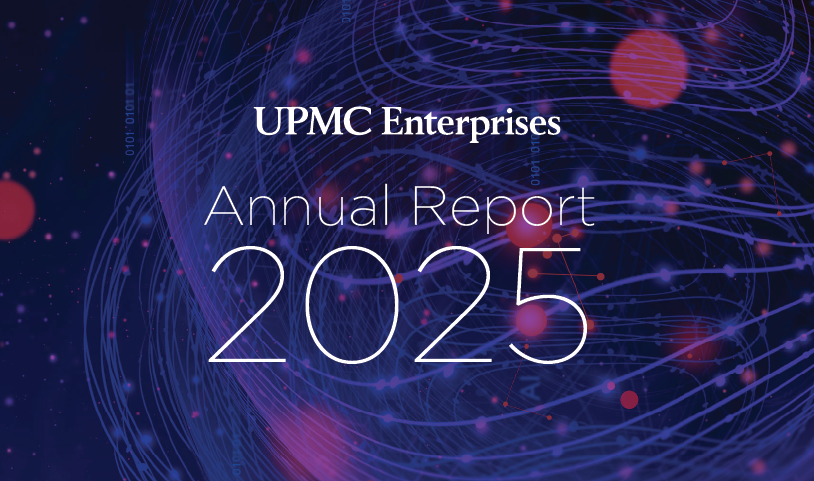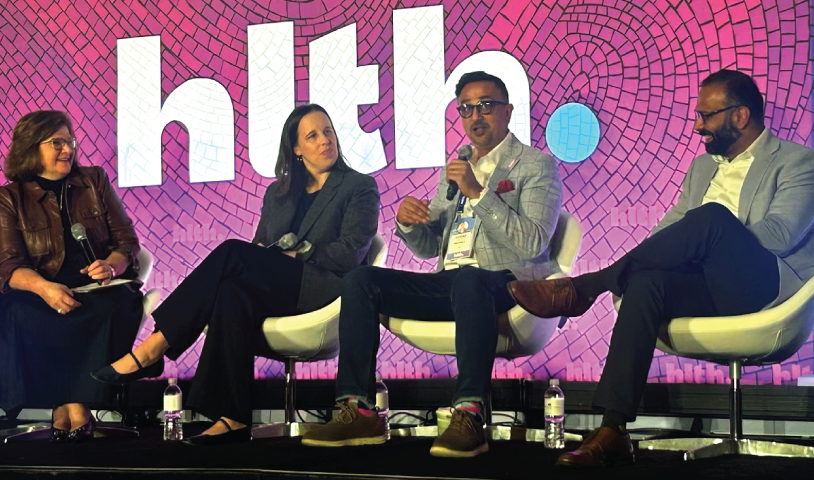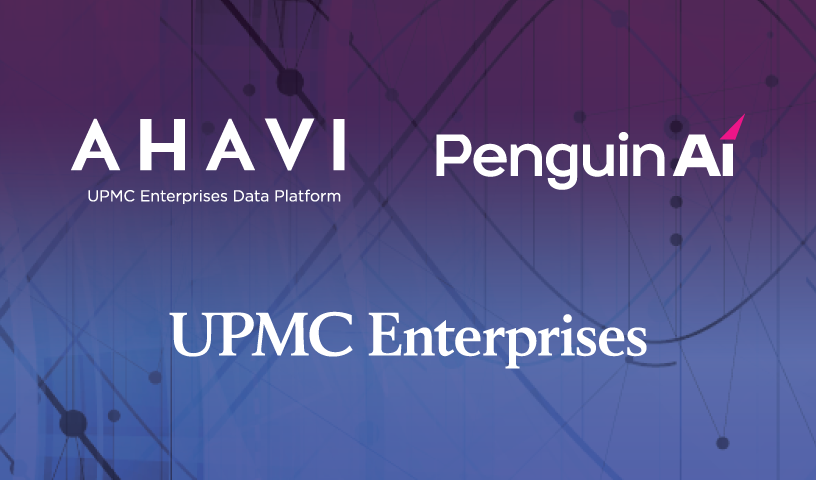
Jul 16, 2025
How UPMC Enterprises is Revolutionizing Health Care Research and Development with Ahavi™ Data Platform
UPMC Enterprises has introduced Ahavi™, a real-world health care data platform, at a pivotal moment in the industry. Health care is experiencing a major shift: the rapid rise of artificial intelligence (AI) and data-driven innovation is transforming how new treatments and technologies are developed. In this new world, organizations that harness comprehensive real-world data will lead the way — accelerating discoveries and improving patient care — while those that fail to adapt risk falling behind.
Recognizing this high-stakes imperative, UPMC Enterprises spent years building Ahavi as a strategic response to empower the leaders of this transformation. Ahavi provides secure access to de-identified clinical data from UPMC’s vast patient population, offering researchers, startups, and industry partners the tools they need to validate AI models, design better clinical trials, and drive breakthroughs grounded in real-world evidence.
The launch of Ahavi comes as the demand for high-quality, primary source-verified health care data has never been greater — fueled by the urgency to test and trust AI solutions, improve trial efficiency, and advance research for better patient outcomes. Ahavi represents the culmination of a decade-long effort by UPMC Enterprises to build a platform that not only aggregates data but turns it into actionable insight. By leveraging UPMC’s extensive data assets and expertise without compromising its standards and rigor regarding data privacy and security, Ahavi is poised to change the game in health care R&D, enabling those who embrace it to reach the “promised land” of faster innovation and improved care.
In this article, we will cover:
- Why health care needs a real-world data platform now: Big changes in health care and technology make platforms such as Ahavi essential for innovators; and the consequences for those who adopt or ignore this trend.
- Key attributes and differentiators of Ahavi: What sets Ahavi apart in the industry — its comprehensive data integration, unique capabilities, and the insights it offers to overcome obstacles on the way to better research and development.
- Who uses Ahavi and how they benefit: The primary user groups, including pharma/biotech companies, AI developers/startups, academic researchers, and how Ahavi addresses their specific challenges, positioning them to be the winners in this new era.
Why Health Care Needs a Real-World Data Platform
A New Era of Data-Driven Innovation: Over the past decade, health care has digitized vast amounts of patient data, from electronic health records to imaging and beyond. At the same time, AI has emerged as a powerful tool with the potential to revolutionize patient care and drug discovery. This convergence marks a significant reordering in the world of health care R&D — one where data is the new currency of innovation. However, many organizations struggle to tap into this wealth of information because data remains siloed, fragmented, and difficult to access. Even advanced health systems can find it challenging to compile a complete, usable patient record from disparate sources. The result? Critical insights are missed, and promising AI algorithms or treatments can falter when moved into real clinical settings due to lack of robust validation.
In today’s health tech sector, market leaders will be those who use real-world data to accelerate research, improve clinical trials, and develop effective AI models. Relying on limited or synthetic data can lead to costly failures in clinical settings. As AI becomes more widely adopted, top health systems need to validate models with real-world data — an essential step for success.
The Need for a Trusted Data Platform: Health care needs a solution that breaks down data silos and provides a comprehensive, reliable source of truth for innovation. This is why UPMC Enterprises built Ahavi. The platform was designed to integrate diverse data sources and deliver ready-to-use datasets in a compliant, secure manner. High-quality, real-world data is essential not only for AI, but also for improving clinical trials and observational research. For instance, pharmaceutical and biotech companies require data on patient populations and care pathways to design better trials and prove the value of therapies. Academic researchers seek large datasets to validate hypotheses and drive scientific discovery. Yet historically, few health systems could provide this access at scale due to technical and organizational barriers. UPMC Enterprises, as the innovation arm of a leading academic medical center, spent years developing deep expertise in data compliance, infrastructure, governance, and analytics to meet this challenge.
“UPMC Enterprises has long recognized the need for a robust platform that could not only store and manage data in a HIPAA-compliant way but also provide actionable insights to improve health care,” said Deepan Kamaraj, director of analytics and informatics at UPMC Enterprises. “We are driven by the goal of delivering the right data at the right time to the right stakeholders. We’re excited to partner with organizations that share our vision of responsibly leveraging data to build the most impactful solutions to improve care for our patients.”
Key Attributes and Differentiators of Ahavi
As the demand for health care data continues to grow, Ahavi is poised to play a pivotal role in shaping the future of innovation for clinical trials, AI development, and research with its substantial store of structured and unstructured data.
The platform’s ongoing development includes plans to integrate additional data sources, such as medical imaging, further enhancing its value proposition. By continually evolving and adapting to the needs of its users, Ahavi is set to remain at the forefront of health care data platforms, driving advancements in drug development, AI, and academic research.
Four primary features set Ahavi apart from other data platforms, making it a valuable asset for its users.
1. Comprehensive Data Integration
Ahavi integrates both structured and unstructured data from various sources, including electronic health records (EHRs), radiology reports, and pathology reports. Structured data, which goes back to 2019, comes from more than 156 million patient encounter records. The unstructured data, which is historic to 2012, includes 154 million ambulatory documents, 123 million adult emergency department and inpatient records, 41 million radiology documents, and other documents. This comprehensive integration ensures that users have access to complete, longitudinal records (on an aggregated, de-identified basis), enabling more accurate analyses and insights.
2. High Linkage Rate
One of the standout features of Ahavi is its high linkage rate between its structured and unstructured data. While many structured and unstructured datasets are available in the market, the linkage rate of data in Ahavi is a minimum 80% and often as high as 99% — far higher than most. These more complete records deliver an unmatched value that can lead to more reliable insights.
3. Speed and Efficiency
In the fast-paced world of R&D, speed is crucial. With Ahavi, datasets are normalized and de-identified within two to four weeks, a game-changing turnaround time. This rapid delivery allows companies to quickly iterate on their models and optimize their clinical trials, significantly reducing the time and cost associated with traditional methods.
4. Regulatory Compliance and Transparency
The Ahavi commitment to regulatory compliance and transparency is another key differentiator. The platform’s robust de-identification and honest broker processes ensure that data privacy is maintained to the highest standards, while its transparent data handling practices facilitate secure and seamless submission packages to regulatory bodies like the FDA. This compliance not only protects patient data and builds trust with users but also streamlines the approval process for new drugs and technologies.
Ahavi Addresses Challenges for Users
Ahavi addresses several critical challenges faced by its three primary user segments: research and development (R&D) for drug development, AI model development, and academic research.
1. Research and Development for Drug Development
Pharmaceutical and biotech companies have long struggled with the inefficiencies of traditional clinical trials. The process of designing and executing trials is time-consuming and costly, often taking over a decade to bring a drug to market. Ahavi revolutionizes this process by providing access to comprehensive clinical data, enabling researchers to design better trials and make informed decisions early in the drug development lifecycle.
By leveraging Ahavi’s insights, companies can identify potential issues and optimize trial designs, ultimately accelerating the time to market for new drugs. The platform also provides an opportunity for pharmaceutical companies to validate the effectiveness of therapies in a real-world setting with the goal of optimizing how medications are being used.
2. AI Model Development
The development of AI models in health care requires vast amounts of high-quality data. Traditionally, companies have relied on synthetic or publicly available data, which often lacks the granularity and accuracy needed for real-world applications. Ahavi offers a unique solution by providing access to de-identified clinical data, allowing AI developers to validate their models against real-world data. This not only enhances the accuracy of AI models but also facilitates smoother integration into health care systems, as the models have already been tested and validated using relevant data.
Investors and strategic partners also benefit from Ahavi’s capabilities in this context. For venture investors and industry partners evaluating health tech innovations, the platform provides assurance that a given AI tool or therapy is backed by solid real-world validation. This increases confidence in funding and adopting new solutions.
3. Academic Research
Academic researchers often face challenges in accessing comprehensive clinical data for their studies. Ahavi bridges this gap by offering a rich repository of structured and unstructured data, enabling researchers to conduct more informed and impactful studies. This access to data supports grant writing and helps quantify the potential impact of new solutions, fostering innovation and advancing scientific knowledge.
Enabling Health Care Advancements with Ahavi
In short, Ahavi creates a virtuous cycle: it helps the creators of new health care solutions prove their value and aids decision-makers in identifying which innovations are truly evidence-based. Ahavi represents a significant leap forward in the utility of health care data. By addressing the unique challenges faced by stakeholders and offering unparalleled features, Ahavi is not just a data platform but a catalyst for innovation. Its ability to provide timely, accurate, and comprehensive data solutions in a compliant manner empowers researchers, developers, and health care professionals to make informed decisions, ultimately improving patient outcomes and advancing health care innovation, research, and development.
Next Steps
- Learn more about Ahavi and contact the team.
- Sign up for the Ahavi newsletter for regular updates on the real-world data platform.
- Read about the introduction of Ahavi at the ViVe health care conference earlier this year.


